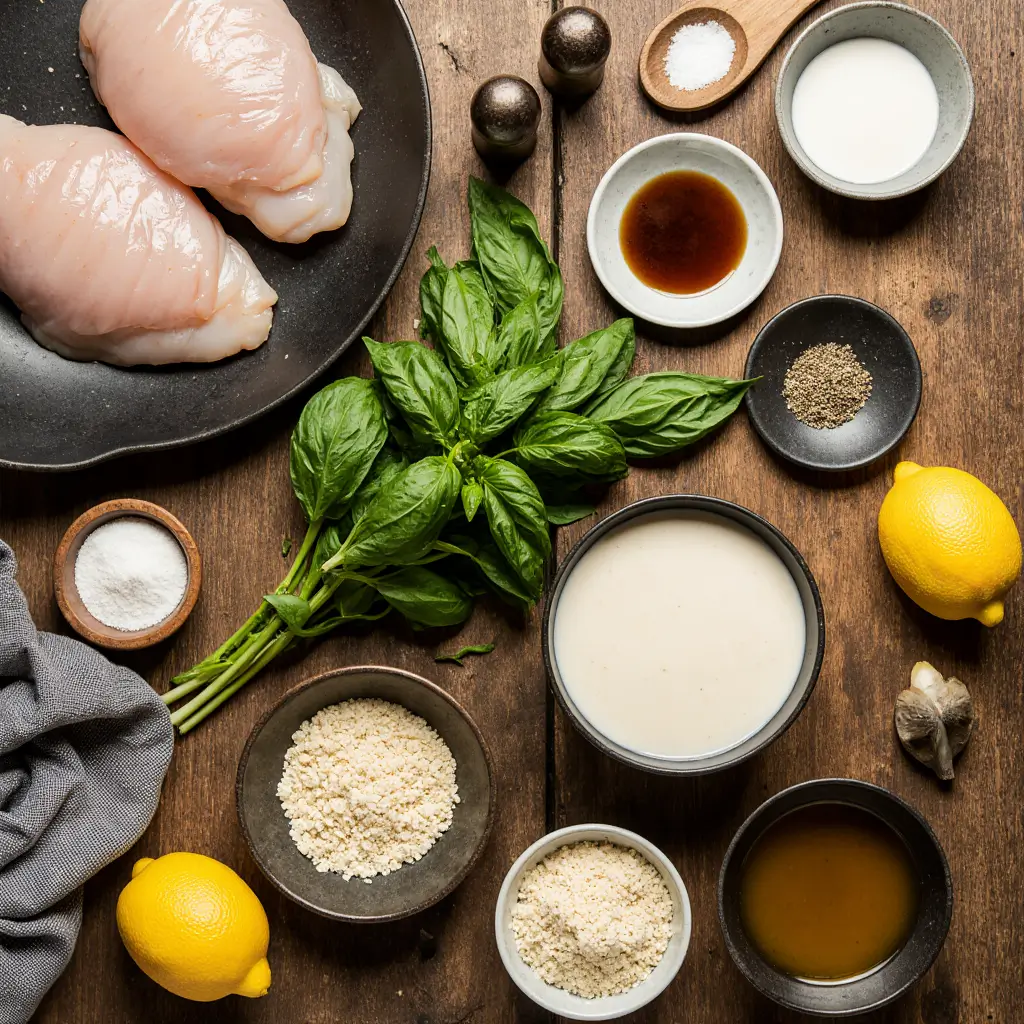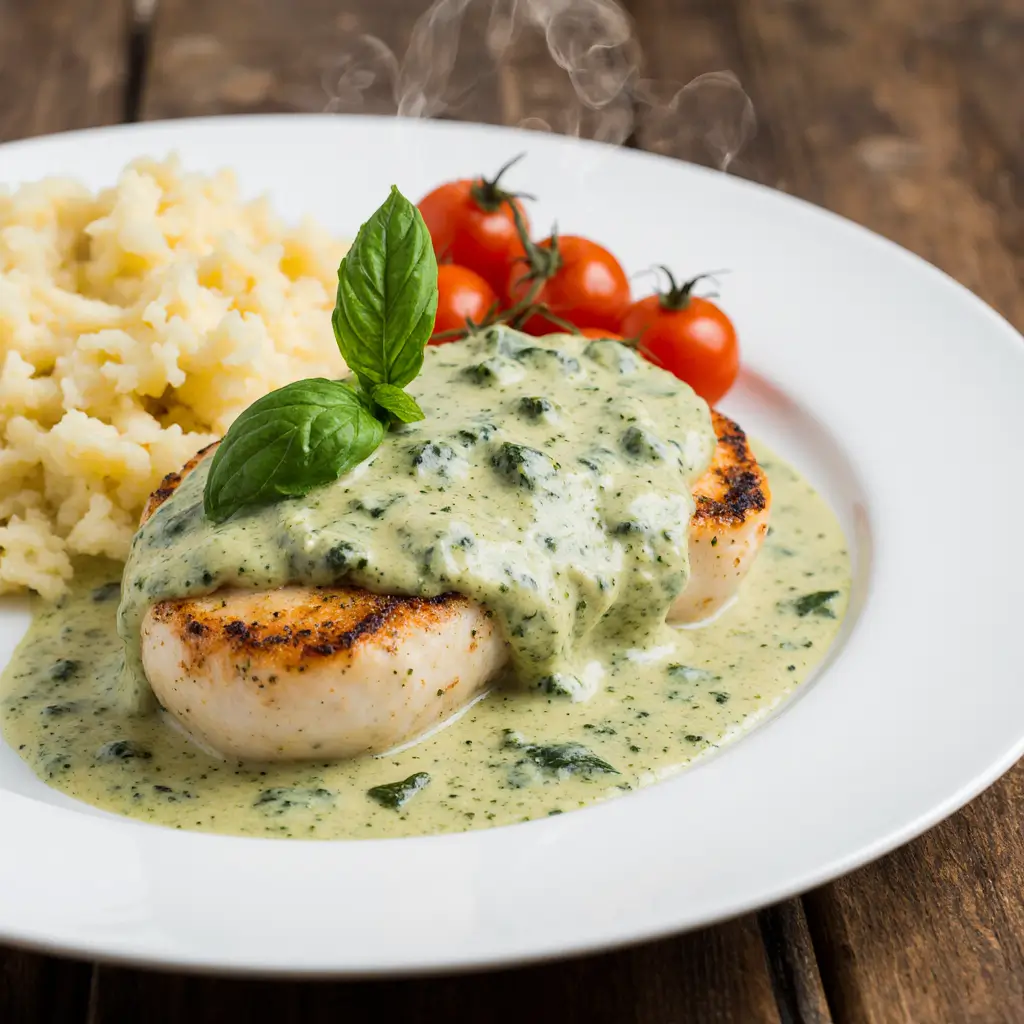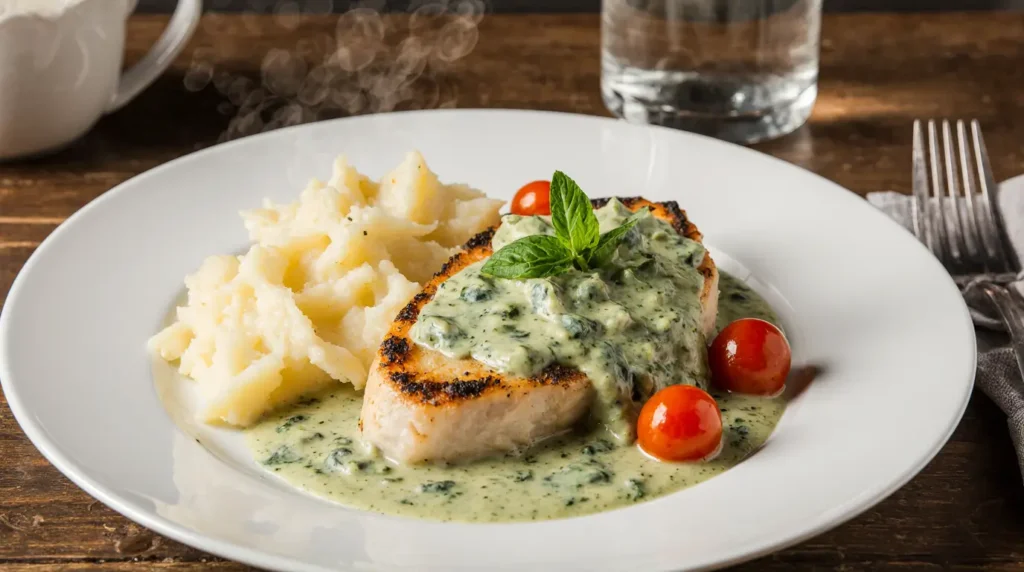Tired of dry, flavorless chicken that tastes like cardboard? You’re not alone. Most home cooks struggle with creating restaurant-quality chicken dishes that don’t require hours of prep or expensive ingredients.
This Chicken in Basil Cream recipe changes everything. In just 20 minutes, you’ll have tender, juicy chicken smothered in a rich, aromatic basil cream sauce that rivals any upscale Italian restaurant. The best part? It uses simple ingredients you probably already have in your kitchen.
As a culinary instructor who’s taught thousands of home cooks over the past 8 years, I’ve perfected this technique to guarantee success every single time. No more guessing, no more disappointment – just consistently delicious results.
In this guide, you’ll discover why this recipe works so perfectly, how to select the best chicken cuts, foolproof cooking techniques, and pro tips that will make you look like a gourmet chef. Plus, I’ll share flavor variations and serving suggestions that will keep this dish exciting for your family week after week.
Table of Contents
Why This Chicken Recipe Works
Chicken in Basil Cream isn’t just another weeknight dinner – it’s a game-changer that solves three major cooking challenges at once:
- Uses affordable, accessible ingredients: No specialty items or expensive cuts required – just chicken, cream, fresh basil, and pantry staples that cost under $15 for a family meal
- Cooks in just 20 minutes total: From pan to plate faster than ordering takeout, perfect for busy weeknights when time is precious but flavor can’t be compromised
- Incredibly versatile for any occasion: Elegant enough for date night, simple enough for Tuesday dinner, and impressive enough for entertaining guests without stress
The magic lies in the technique – searing chicken for maximum flavor development, then building a silky cream sauce in the same pan to capture all those delicious browned bits. This one-pan method creates layers of flavor while keeping cleanup minimal.
Choosing the Right Chicken
Success with Chicken in Basil Cream starts with selecting the perfect cut. Not all chicken is created equal, and your choice directly impacts the final result.
Best Cuts for This Recipe
Chicken thighs (bone-in, skin-on) are the absolute winner for this dish. The higher fat content keeps the meat incredibly juicy during the quick cooking process, while the skin crisps beautifully and adds texture contrast to the creamy sauce. Thighs also have more robust flavor that stands up perfectly to the rich basil cream.
Boneless, skinless chicken thighs work as a close second if you prefer easier eating. They cook slightly faster and still maintain that tender, juicy texture that makes this dish special.
Chicken breasts can work but require extra attention to prevent overcooking. If using breasts, pound them to even thickness (about ¾ inch) for consistent cooking.
Buying Tips
Look for chicken with a fresh, pink color and avoid any pieces with gray or yellow tinge. The meat should feel firm to the touch, not slimy or sticky. If buying from a butcher, ask for chicken that was processed within the last 2-3 days for optimal freshness and flavor.
For bone-in thighs, choose pieces that are roughly the same size to ensure even cooking. Avoid packages with excessive liquid at the bottom, which can indicate the chicken has been sitting too long.
Substitutions
Can’t find thighs? Bone-in chicken drumsticks work wonderfully with this recipe – just increase cooking time by 5-7 minutes. For a leaner option, use chicken tenderloins but reduce cooking time to 8-10 minutes total to prevent drying out.
Ingredients & Prep
The beauty of Chicken in Basil Cream lies in its simplicity. Every ingredient serves a specific purpose in creating the perfect balance of flavors and textures.

Chicken Prep Essentials
Start by patting your chicken completely dry with paper towels – this is crucial for proper browning. Moisture is the enemy of that golden, crispy skin we’re after. Season generously with salt and pepper at least 15 minutes before cooking, allowing the seasoning to penetrate the meat.
If using bone-in thighs, trim any excess skin or fat, leaving just enough for flavor and texture. For boneless cuts, check for any remaining cartilage or tough bits and remove them for the best eating experience.
Let chicken come to room temperature for 20-30 minutes before cooking. Cold chicken hits a hot pan unevenly, leading to tough, overcooked edges and undercooked centers.
The Perfect Basil Cream Base
Fresh basil is non-negotiable for this recipe – dried basil simply won’t deliver the bright, aromatic flavor that makes this dish special. You’ll need about 1 cup of fresh basil leaves, stems removed.
Heavy cream (at least 35% fat content) creates the rich, silky texture that coats the chicken beautifully. Half-and-half or milk won’t provide the same luxurious mouthfeel or stability when heated.
Garlic, shallots, and white wine form the flavor foundation. Use fresh garlic (never pre-minced from a jar), finely diced shallots for sweetness, and a dry white wine like Pinot Grigio or Sauvignon Blanc.
Pantry Staples You’ll Need
High-quality olive oil or butter for searing – don’t skimp here as it directly impacts flavor. Chicken stock adds depth to the sauce. Fresh lemon juice brightens the rich cream, while grated Parmesan cheese adds savory complexity.
Keep kosher salt, freshly cracked black pepper, and red pepper flakes on hand for seasoning adjustments.
Step-by-Step Cooking Instructions
Master these four simple steps, and you’ll have perfect Chicken in Basil Cream every single time.
Pre-Cooking Prep
Remove chicken from refrigerator 20-30 minutes before cooking. Pat completely dry with paper towels and season generously with salt and pepper on both sides. This initial seasoning time allows the flavors to penetrate while the meat comes to room temperature for even cooking.
Heat a large, heavy-bottomed skillet (cast iron or stainless steel works best) over medium-high heat. Add 2 tablespoons of olive oil and let it shimmer – this indicates the perfect temperature for searing.
The Perfect Sear
Place chicken skin-side down in the hot pan, leaving space between pieces. Don’t move them for 4-5 minutes – resist the urge to peek! You’ll hear sizzling initially, then it will quiet down as moisture evaporates and browning begins.
Flip when the skin releases easily and shows deep golden-brown color. Cook another 4-5 minutes on the second side. For bone-in thighs, the internal temperature should reach 165°F.
Remove chicken to a plate and tent with foil. Don’t worry if it’s not completely cooked through – it will finish in the sauce.
Building the Basil Cream Sauce
In the same pan (don’t clean it – those browned bits are flavor gold!), reduce heat to medium and add minced shallots. Cook for 1-2 minutes until fragrant, then add garlic and cook 30 seconds more.
Pour in ½ cup white wine to deglaze, scraping up all those delicious browned bits. Let wine reduce by half, then add ¾ cup heavy cream and ¼ cup chicken stock.
Bring to a gentle simmer, then add fresh basil leaves and return chicken to the pan. Simmer 3-4 minutes until sauce thickens slightly and chicken is heated through.
Final Touches
Remove from heat and stir in fresh lemon juice, grated Parmesan, and final seasoning adjustments. The sauce should coat the back of a spoon but still flow easily.
Taste and adjust – add more lemon for brightness, salt for depth, or red pepper flakes for heat. Garnish with fresh basil leaves and serve immediately.
Pro Tips for Perfect Chicken
These insider techniques separate good home cooks from great ones.
Avoiding Tough, Dry Chicken
Never overcrowd your pan – cook in batches if necessary. Crowded chicken steams instead of sears, resulting in gray, rubbery texture. Each piece needs space for proper browning.
Don’t flip too early. Chicken will release naturally when properly seared. If it’s sticking, it’s not ready to flip yet.
Use a meat thermometer for foolproof results. Thigh meat is done at 165°F, but it’s actually better at 170-175°F for optimal texture and juiciness.
Essential Tool Recommendations
A heavy-bottomed skillet distributes heat evenly and prevents hot spots that burn the sauce. Cast iron or tri-ply stainless steel are ideal choices.
An instant-read thermometer takes the guesswork out of doneness. Digital models with thin probes give the most accurate readings without creating large holes in the meat.
A fine-mesh strainer helps achieve silky-smooth sauce by removing any lumps or bits of cooked garlic that might have browned too much.
Storage and Reheating Magic
Store leftover Chicken in Basil Cream in the refrigerator for up to 3 days. The flavors actually improve overnight as they meld together.
For reheating, use low heat and add a splash of cream or chicken stock to restore the sauce’s consistency. Microwave reheating works but can make the chicken rubbery – stovetop is always better.
Freeze cooked chicken in the sauce for up to 2 months. Thaw overnight in the refrigerator and reheat gently, whisking in fresh cream if the sauce separates.
Flavor Variations
Keep your family excited with these delicious twists on the classic recipe.
Spicy Heat Lovers
Transform this into a fiery feast by adding 1-2 teaspoons of red pepper flakes during the sauce building stage. For deeper heat, include a finely minced jalapeño with the shallots, or stir in a tablespoon of sriracha at the end.
Chipotle peppers in adobo sauce add smoky heat – just one minced pepper transforms the entire dish with complex, smoky flavor that pairs beautifully with the basil.
Keto and Low-Carb Friendly
This Chicken in Basil Cream recipe is naturally keto-friendly! The rich fats from cream and chicken skin provide perfect macros for low-carb lifestyles.
Boost the fat content by finishing with an extra tablespoon of butter or using full-fat coconut cream instead of heavy cream for dairy-free keto followers.
Serve over cauliflower rice, zucchini noodles, or spaghetti squash instead of traditional pasta to keep carbs minimal while maintaining satisfaction.
Global Flavor Adventures
Mediterranean Style: Add sun-dried tomatoes, kalamata olives, and fresh oregano along with the basil for Greek-inspired flavors.
Thai Fusion: Replace basil with Thai basil, add a splash of fish sauce and coconut milk instead of cream, plus a squeeze of lime for bright, Southeast Asian flavors.
Mexican Twist: Use Mexican crema instead of heavy cream, add fresh cilantro with the basil, and finish with a squeeze of lime and diced avocado.
Serving Suggestions
The right accompaniments turn great Chicken in Basil Cream into an unforgettable meal.
Perfect Pasta Pairings: Serve over al dente fettuccine, pappardelle, or gnocchi to soak up every drop of that luxurious sauce. Fresh pasta works beautifully, but high-quality dried pasta like Barilla or De Cecco delivers excellent results.
Vegetable Sides: Roasted asparagus, sautéed spinach, or grilled zucchini provide fresh contrast to the rich cream sauce. Roasted cherry tomatoes add bright acidity that cuts through the richness perfectly.
Starch Options: Creamy polenta, garlic mashed potatoes, or crusty artisan bread make excellent vehicles for the sauce. Rice pilaf or wild rice also work wonderfully for a more rustic presentation.
Wine Pairings: Crisp white wines like Pinot Grigio, Sauvignon Blanc, or unoaked Chardonnay complement the basil and cream beautifully. For red wine lovers, a light Pinot Noir won’t overpower the delicate flavors.
Beer Matches: Belgian wheat beers, pilsners, or light ales provide refreshing contrast. Avoid hoppy IPAs that will clash with the creamy sauce.
FAQs
Can I use frozen chicken?
Yes, but thaw completely first and pat extra dry. Frozen chicken releases more moisture during cooking, which can prevent proper browning and dilute the sauce. Thaw overnight in the refrigerator for best results.
How do I fix overcooked chicken?
If your chicken becomes tough, slice it thinly and return to the warm (not hot) sauce for 2-3 minutes. The residual heat and moisture from the cream can help salvage overcooked meat. Next time, use a thermometer for foolproof results.
Is this recipe safe for pregnant women?
Absolutely! Just ensure the chicken reaches 165°F internal temperature and use pasteurized cream and cheese. Fresh herbs are safe and beneficial during pregnancy. This recipe actually provides excellent protein and healthy fats for expecting mothers.
Can I make this dairy-free?
Replace heavy cream with full-fat coconut milk and omit the Parmesan cheese. The flavor will be different but still delicious. Cashew cream (blend 1 cup soaked cashews with 1 cup water) also works well for a neutral-tasting dairy alternative.
How can I make the sauce thicker?
If your sauce seems thin, simmer uncovered for an extra 2-3 minutes to reduce naturally. Alternatively, mix 1 tablespoon of cornstarch with 2 tablespoons of cold cream and whisk into the simmering sauce.
What if I don’t have white wine?
Substitute with additional chicken stock plus 1 tablespoon of white wine vinegar or lemon juice for acidity. The wine adds depth, but the dish will still be delicious without it.
Conclusion
Ready to transform your weeknight dinners forever? This Chicken in Basil Cream recipe delivers restaurant-quality results in just 20 minutes, proving that incredible flavor doesn’t require hours in the kitchen or expensive ingredients.
The combination of perfectly seared chicken and silky basil cream sauce creates a meal that’s elegant enough for entertaining yet simple enough for busy Tuesday nights. Your family will think you’ve been hiding secret culinary skills, and you’ll love how effortlessly it comes together.



1 Comment
vetxjv